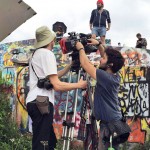 Crowdfunded filmmakers will be able to shoot on film for a lot less money thanks to a partnership between Kodak and Kickstarter. Kodak says it will provide free 35mm or Super 16mm film stock for select projects, up to a total of around $20, 000 for 35mm film, depending on the total budget. Beyond that, the company will provide discounted film and mentoring for packaging, financing and sales strategies. The choice of filmmakers appears to be at Kodak’s discretion, but so far the company has picked several Kickstarter productions that will launch this spring. Kickstarter has successfully funded 20, 000 productions totalling $330 million so far, though it didn’t say which were shot on film. The platform has garnered a lot of bad publicity in the past by funding large projects like Veronica Mars and Zach Braff’s Wish I Was Here , since the well-known producers probably could have raised the cash elsewhere. On the other hand, it’s an excellent platform for up-and-coming filmmakers, and has helped get Oscar-nominated projects with very small budgets off the ground. Kodak VP Anne Hubbell says that “Kodak understands that artists working at all budget levels strive to tell their stories with the unique quality and emotion that film provides.” The company points out that footage can be purchased by Kickstarter producers in eighteen countries, including the US, UK, France and Canada. Kodak’s situation is a lot more secure in the film industry since it struck a deal with Hollywood to supply film for the foreseeable future. DarkFall, a Kickstarter film backed by Kodak However, it’s equally likely that many young, inexperienced directors would rather shoot digital, given advantages like speed and the ability to easily review takes. As we have pointed out , the costs of shooting on film go way beyond the stock itself. Filmmakers also need to consider processing and transferring footage to a format that can be edited, color corrected and converted to a final screening format. That, combined with the lower sensitivity of film compared to digital cameras (which necessitates more complex lighting) means that the total budget will likely still be higher, even with the film thrown in. That said, it’s always good to have choices, so if it’s an aesthetic that a director absolutely can’t live without, good old celluloid is now a much more feasible option. Source: Kodak
Crowdfunded filmmakers will be able to shoot on film for a lot less money thanks to a partnership between Kodak and Kickstarter. Kodak says it will provide free 35mm or Super 16mm film stock for select projects, up to a total of around $20, 000 for 35mm film, depending on the total budget. Beyond that, the company will provide discounted film and mentoring for packaging, financing and sales strategies. The choice of filmmakers appears to be at Kodak’s discretion, but so far the company has picked several Kickstarter productions that will launch this spring. Kickstarter has successfully funded 20, 000 productions totalling $330 million so far, though it didn’t say which were shot on film. The platform has garnered a lot of bad publicity in the past by funding large projects like Veronica Mars and Zach Braff’s Wish I Was Here , since the well-known producers probably could have raised the cash elsewhere. On the other hand, it’s an excellent platform for up-and-coming filmmakers, and has helped get Oscar-nominated projects with very small budgets off the ground. Kodak VP Anne Hubbell says that “Kodak understands that artists working at all budget levels strive to tell their stories with the unique quality and emotion that film provides.” The company points out that footage can be purchased by Kickstarter producers in eighteen countries, including the US, UK, France and Canada. Kodak’s situation is a lot more secure in the film industry since it struck a deal with Hollywood to supply film for the foreseeable future. DarkFall, a Kickstarter film backed by Kodak However, it’s equally likely that many young, inexperienced directors would rather shoot digital, given advantages like speed and the ability to easily review takes. As we have pointed out , the costs of shooting on film go way beyond the stock itself. Filmmakers also need to consider processing and transferring footage to a format that can be edited, color corrected and converted to a final screening format. That, combined with the lower sensitivity of film compared to digital cameras (which necessitates more complex lighting) means that the total budget will likely still be higher, even with the film thrown in. That said, it’s always good to have choices, so if it’s an aesthetic that a director absolutely can’t live without, good old celluloid is now a much more feasible option. Source: Kodak





